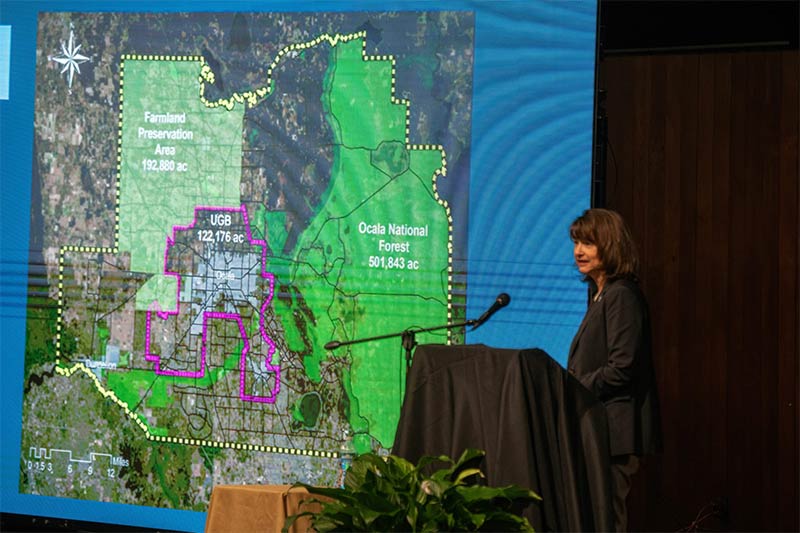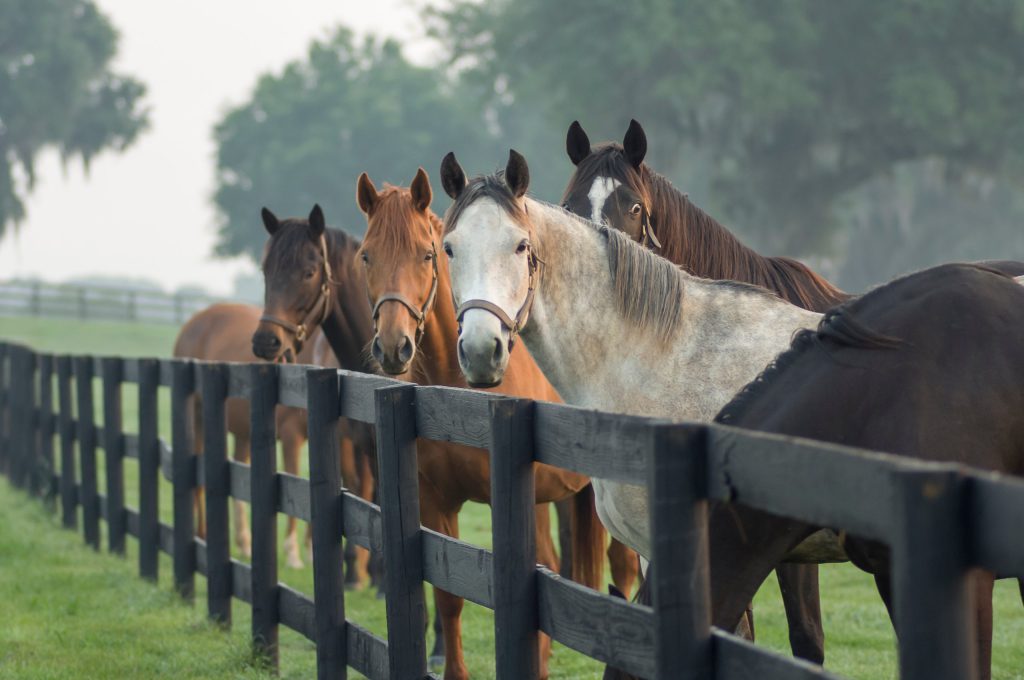A Conversation About Transportation with Marion County’s Tracy Straub
There was never a time where Marion County wasn’t home to Tracy Straub. A fifth-generation Marion County Floridian, she has a deep perspective on the changes that have taken place in the County and its needs going forward. Straub’s career at the County began 21 years ago. She has been the County Engineer and now leads both Public Works and Growth Services as an Assistant County Administrator. We were honored to have her share the latest on road construction in the County at our Conservation Summit in November. In her presentation, she shared timelines and details for the major projects coming to fruition around the County, particularly those that will help alleviate congestion and pinch-points on I-75 and those impacting horse farms and the equine industry.
Straub focused on the area known as the Ocala Triangle, which includes SR 200 and SW 60th and SW 80th Avenues. She also gave an update on the projects at the CR 318 and I-75 intersection in the Sunny Oaks/Irvine area.
Concentrated Growth
Over the past five years, Marion County has experienced rapid growth of industrial, commercial and residential development. As a result, there are 42 road improvement projects in the County. One indicator of growth is the number of building permits issued over the past 12 years.
“In the last couple of years, we have been with issuing around 5,000 certificates of occupancy for residential building permits,” said Straub. “In 2019, we were only half that number and when you go back as far as 2010, which, of course we were sitting in the economic recession, there were only a couple hundred single-family residential permits issued,” said Straub.
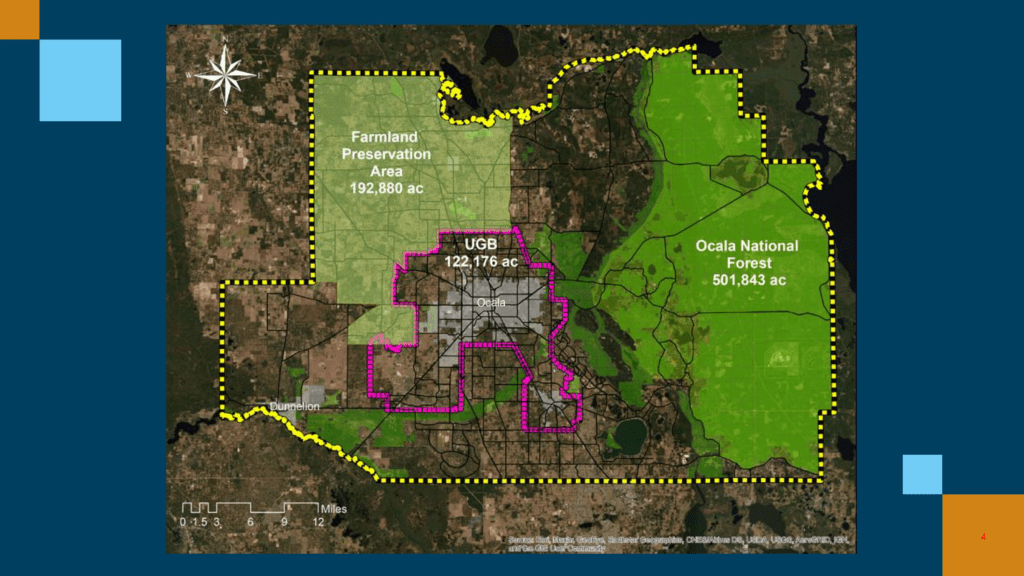
While the growth is unrelenting, it’s important to understand that Marion County’s land uses funnel development into a concentrated area. Straub reminded us that forty-nine percent of the County is made up of the Ocala National Forest, other conservation lands, and rivers, springs, and lakes. About nineteen percent of it is the Farmland Preservation Area where development is limited. Another twenty-one percent is rural land or designated as low-density land use. The Urban Growth Area only encompasses about eleven percent of the County. The County is home to abundant natural resources, including two-hundred miles of trails for hiking and biking, and equestrian use, more than 150 miles of streams and rivers, three first magnitude springs, five second magnitude springs, twenty-plus third magnitude springs, and countless other springs, Straub said.
“We continue to thrive as a natural gem, and we recognize that as we watch our growth and development occur,” she said. “But through it all, of course, we do have a road network.”
The Structure of the Infrastructure
Marion County maintains approximately 2,500 centerline miles of road. About half of the roads are subdivision roads and another half are the major road network. In addition, there are many roads that the County does not maintain. These roads are maintained by another agency such as FDOT, or another municipality. There are also private subdivisions and dirt roads in the Ocala National Forest that were never accepted into the county maintenance system. In addition to the road system, there drainage retention areas, right of ways, 92,000 traffic signs and 131 traffic signals.
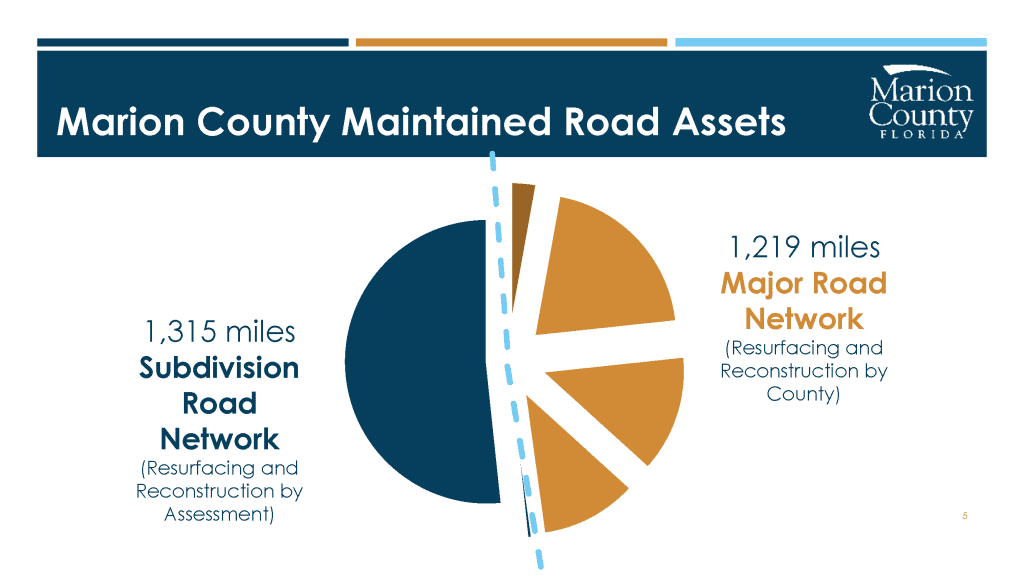
To build and design roads, the County partners with the Ocala Marion Transportation Planning Organization (TPO) Board, which is the policy-making body responsible for the overall guidance of the transportation planning process in Marion County. The TPO Board is comprised of twelve voting members including the City of Ocala Mayor and four members of the City Council; all five Marion County Commissioners; and one representative each from the Belleview City Commission and the Dunnellon City Council. The Florida Department of Transportation District 5 Secretary is a member of the TPO Board as a non-voting member.
Planning and building roads is a lengthy and time-consuming process that takes 15 to 20 years.
The TPO develops a 25-year planning document, the 2045 Long Range Transportation Plan (LRTP) that outlines the vision for transportation in Marion County. The LRTP considers all modes of transportation, including roadways, transit, bicycles, pedestrians, freight and aviation. The LRTP plan includes approximately $4 Billion worth of programming anticipated between 2020 and 2045, which is funded by several agencies, including Marion County, all of the cities and FDOT. However, there are an additional $750 million of unfunded needs also identified.
In addition to the 25-year plan, there is a five-year plan, the Transportation Improvement Program (TIP) serves as the short-range transportation planning document for Ocala/Marion County.
“In our current five-year plan there are $186 Million worth of projects funded in the five-year projection,” said Straub.
Road improvement projects are categorized into different types. The capacity projects, which are funded at $131 million, are focused on adding lanes, signalized improvements, and turn lanes. New capacity roads have a grass median, bike lanes on both sides, a sidewalk on one side, and a multi-use trail on the other side.
“This is a lot of funding for Marion County and I want to pause and to reflect on that because that has a lot to do with the sales tax initiative and our penny sales tax,” she said. “Your TIP does not include sales tax revenues beyond the collections in December 31, 2024 so it’s important to know that we have a lot of money available to us to try to catch up from where we weren’t able to produce projects during the economic downturn, but we don’t budget beyond what we know we’ve been given.”
Photos of Tracy Straub, Rob Desino and Linda Bammann by Sean Dowie Photography. Remaining graphics provided by Marion County.
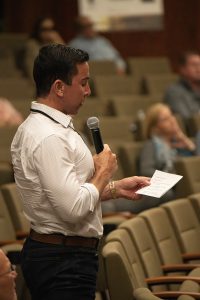
Question from Rob Desino of Ocala Horse Properties
QUESTION:
The Secretary talked about the new I-75 interchange at 49th Street and the timing of that work. The County plans to extend 49th Street to the west to connect with NW 70th Avenue, also known as 225A.
- How long do you project it will be before we can drive on the new NW 49th Street?
- And, will NW 60th Avenue, the road by the airport, be extended to the north to connect with the new NW 49th Street?
ANSWER:
Straub stated that portions of the section of NW 49th Street, west from the interstate to CR 225A, is currently in design and it is planned to be a four-lane road, but it will first be will be built as a two-lane road. Next year, the County is prepared to start constructing about a mile section of the road from 44th Avenue going west just past the rear entrance of Ocala Preserve, located on US 27.
The County does not have all the right away secured moving further west to 225A, but the process for the right of way acquisition will begin next year. Straub predicted that it would take about three years for the road to reach CR 225A.
NW 60th Avenue, also known as Airport Road, ends at US Hwy 27. The County reserved the right of away on the west side of the Ocala Preserve subdivision, but the County does not have a road planned. However, the County does recognize that extending NW 60th Avenue north to NW 49th Street make for a good potential connector and that’s why they reserved the right of way, Straub stated.
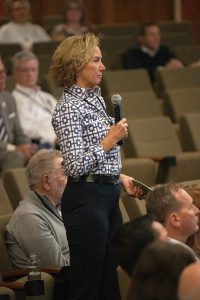
Question from Linda Bammann of Laughing Horse Farm
QUESTION:
There are 2 large projects approved on Highway 318, the Sunny Oaks development and the WEC Jockey Club.
The Board of County Commission’s procedure for approving both these projects has been challenged. How long do you project it will be before these challenges will be resolved? Days, months or years?
ANSWER:
For the Sunny Oaks project, the judges need to review the challenge that was filed. The County has not been asked to provide a response to that challenge yet.
For the WEC Jockey Club, which is a different type of challenge, an administrative hearing date has been set for early next year and the County will participate in the hearing.
The length of time before the challenges are resolved could be months or it could take longer.
“We know we’re into months,” she said. “Neither project is able to move forward with construction without having both of these items buttoned up, so while we will continue to work with them through the permitting process. We would not be able to issue any permits until they’ve resolved both of those challenges that are out there.”
SPECIFIC ROAD PROJECTS
SE Emerald Road to be Extended:
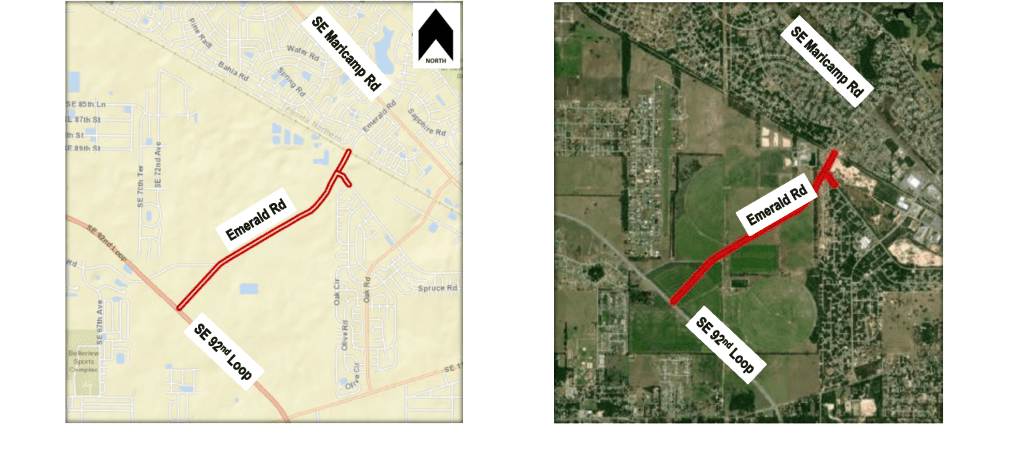
SE Emerald Road already exists inside Silver Spring Shores and CR 464 is the only major corridor that runs through that community. SE Emerald Road is already over capacity. The County is extending Emerald Road further to the west to connect with SE 92nd Loop, which is a four-lane road that goes from the Baseline area and to the Belleview area.
Marion Oaks Manor to be Extended with Flyover I-75:
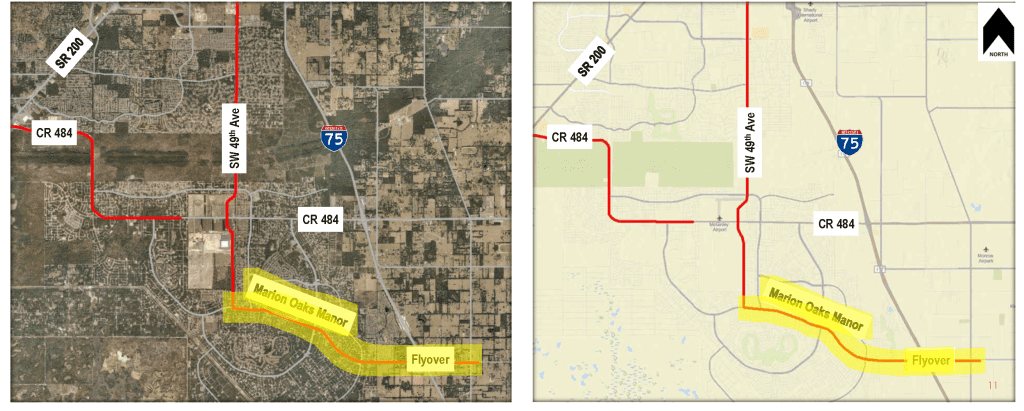
Marion Oaks Manor will be four-laned and will be extended east to a flyover over I-75 to allow traffic to travel to the east side of the County.
County Road 484 to be Four-Laned to SR 200:
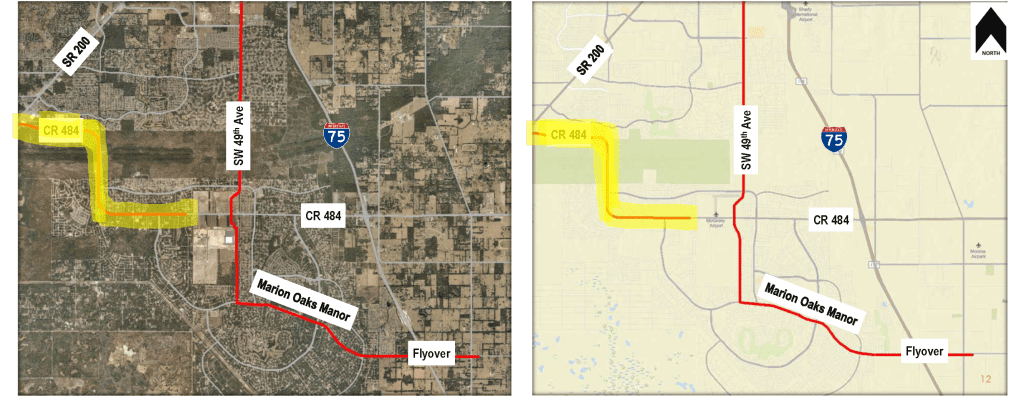
Part of CR 484 is four lanes from I-75 to just past the Florida Crossroads Commerce Park. The Dollar Tree distribution facility recently built a facility there and several other facilities also plan to build in the Commerce Park, so there is a need to four-lane CR 484 to SR 200.
SW 49th Avenue Goals:
- North -South Connector
- Relief to I-75
- Relief to CR 484
- Relief to SR 200
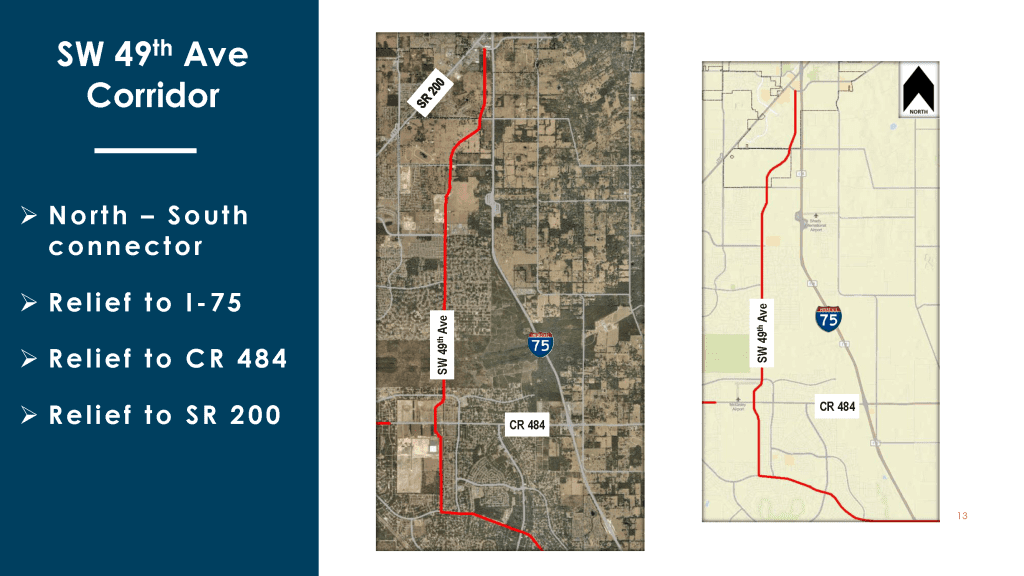
A portion of SW 49 exists in the south end of the County. The road will be extended to connect to the Marion Oaks Manor flyover road and go through the Commerce Park and through the greenway pass at the Cross Florida Greenway. The county has completed the four-lane segment from SW 95th Street (near Liberty Middle School) north to SW 66th Street. Another road segment will connect to SW 42nd Street near the backside of the Heath Brook Mall. The City of Ocala will continue 42nd Street north.
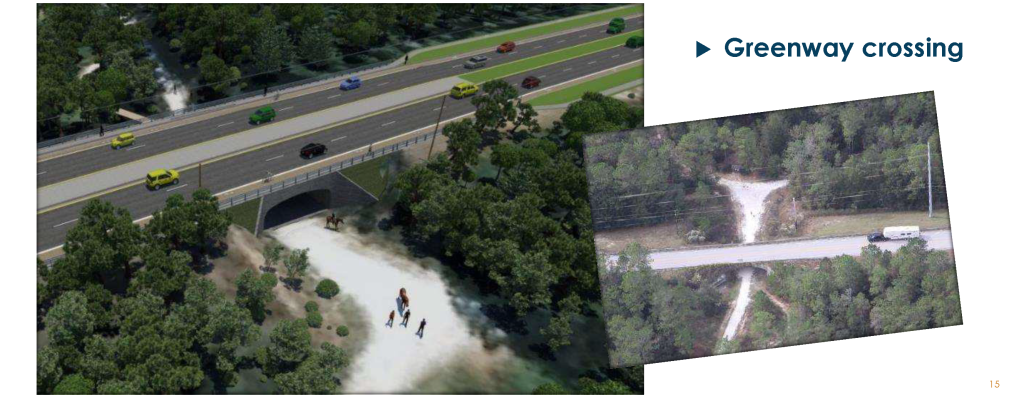
SW 80th/70th Avenue Corridor:
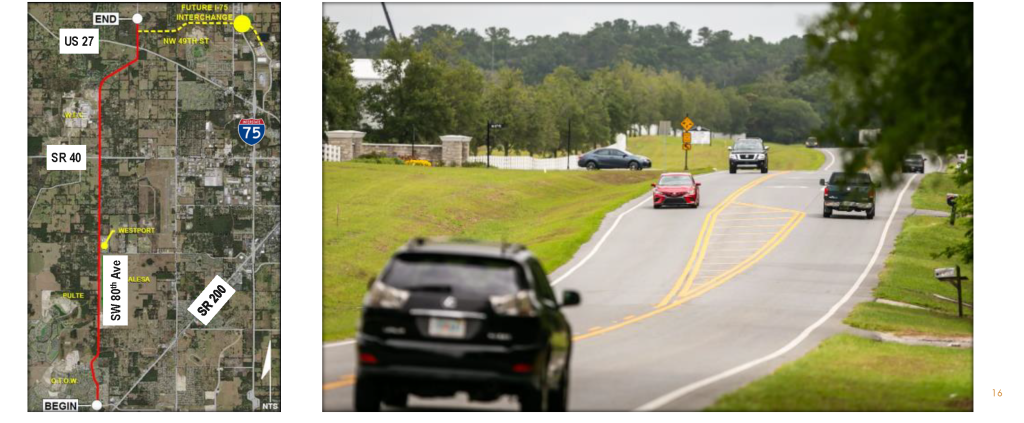
This road improvement project is an 11-mile north and south corridor that starts north of SR 200 and ends at about one-half mile north of US Hwy 27 on CR 225A. The road will be four-laned in multiple phases. The intersections at US Hwy 27 and SR 40 will be improved with turn lanes. In addition, two existing east-west roads, SW 38th Street near the new Calesa Township subdivision, and SW 80th Street, will also be widened to four lanes. SW 80th Street touches SW 80th Avenue and SR 200.
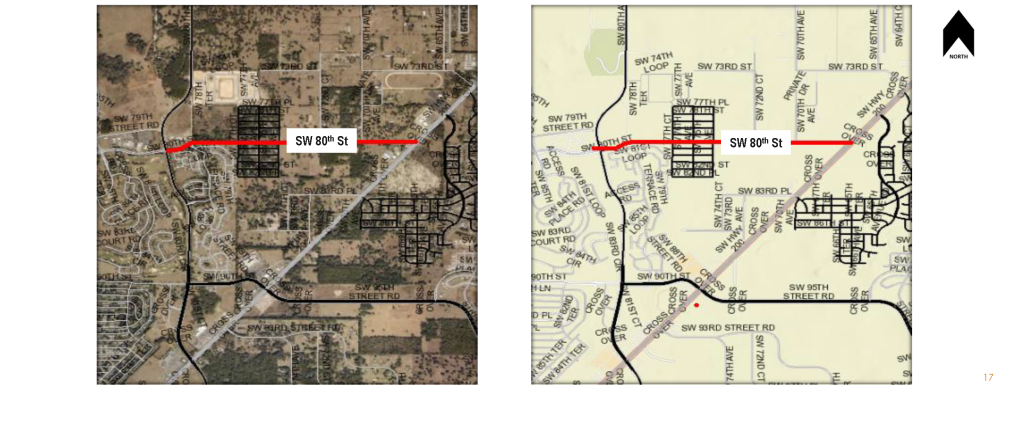
Northwest 49th/35th Street Corridor: New Four Lane East-West Connector:
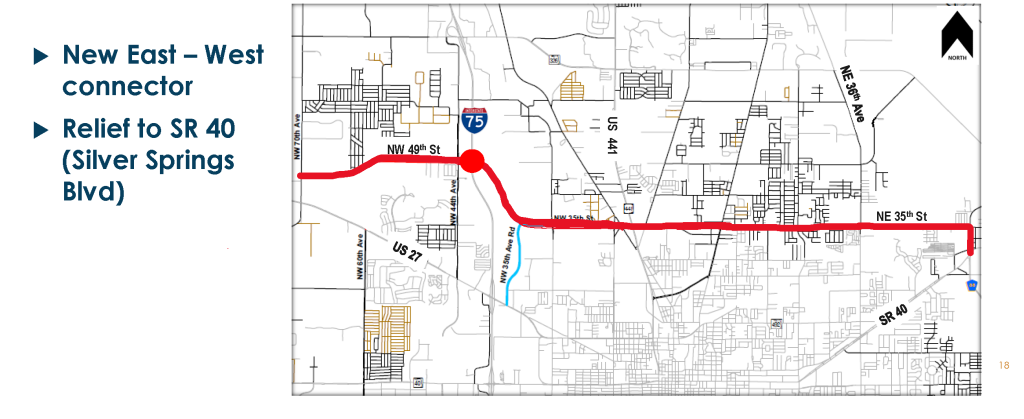
This is a proposed four-lane road that will stretch from CR 225A from just north of US Hwy 27 west through the new I-75 interchange at NW 49th Street to the 489 Commerce Park on the east side of the interstate, then become NW 35th Street and continue east to end near Baseline Road and SR 40 area in Silver Springs. This road will relieve traffic on SR 40 and CR 326.
The new interchange at NW 49th Street has been a 15-to-20-year project in the works for Marion County, said Straub. Construction was initially planned for the 2040s, but due to the urgent need to provide relief to I-75, Marion County worked with DOT and became a funding partner. The new interchange is projected to begin construction in early 2025 and the total cost is nearly $80 million.
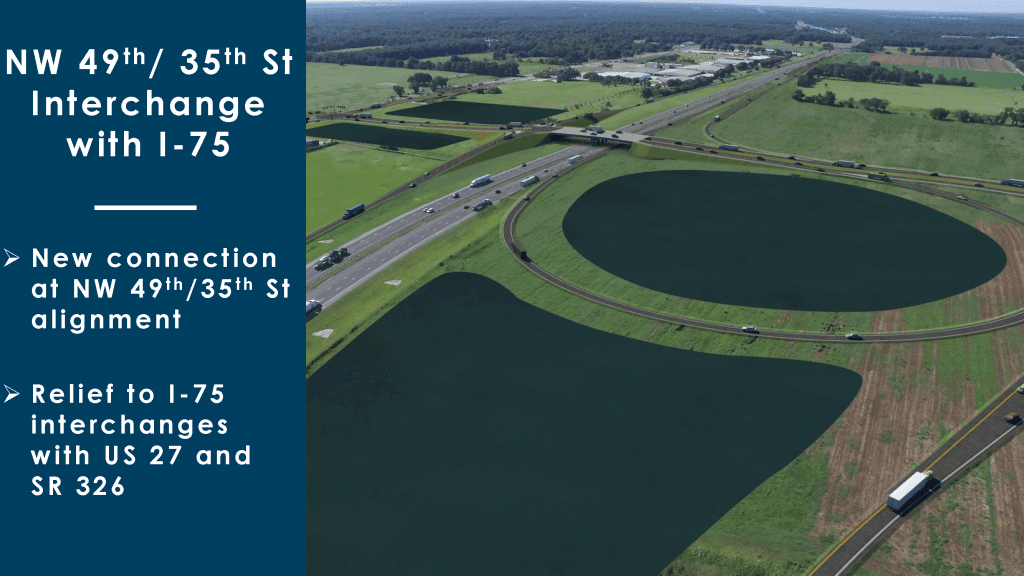
“This is been a great partnership with FDOT and we’re very proud of it,” she said. “We think that this is extremely important for our community. This interchange has been envisioned for quite a while.”
CR 318 and I-75:
The County does not have any active road improvement projects at this intersection. However, two large developments, Sunny Oaks and the WEC Jockey Club, were recently approved at the land use level. The County has not received any additional submittals beyond the request to change the land-use and zoning to allow for future development.
Straub stated that the County conducted a planning level study to determine the cost of the traffic improvements as if both projects had moved forward with a one-hundred percent build-out. The study determined that the cost was about $61 million, but due to proportionate share, the developers would be responsible for ninety-eight percent of the road improvement costs.
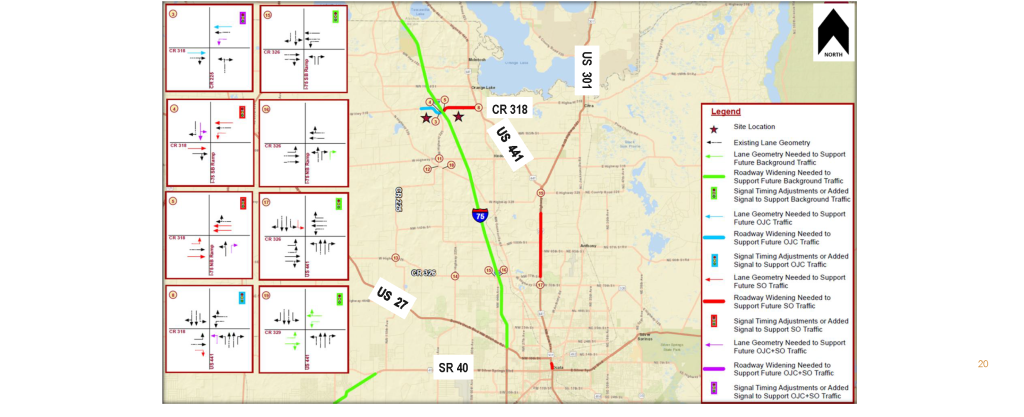
“All of these projects still need that detailed study for the traffic,” she said. “However, we don’t know that those projects will come in at the same time, so one project could come in before the other and then the impacts would shift and the timing of those improvement needs would shift.”
For example, with a full build out, CR 318 would need to be widened from two lanes to four lanes and also improvements to the intersection at CR 225A and CR 318 would be required.
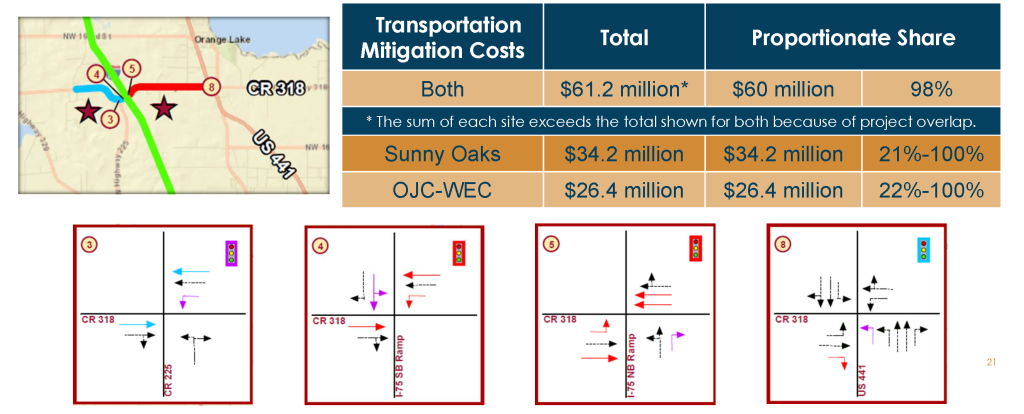
Watch the entire Summit presentation online:
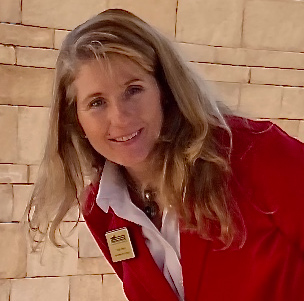
What About Zoning?
The Zoning regulations are found in the Land Development Code, which is a separate document with specific guidelines to implement the Goals, Objectives, and Policies of the Comprehensive Plan.
Zoning regulates development through land use classifications and specifies the areas in which residential, industrial, recreational or commercial activities may take place. The Land Development Code was adopted through a series of ordinances by the County Commission, which means that the regulations cannot be changed or waived, except by a further vote of the County Commission.
It is the vision and mission of Horse Farms Forever to inspire conservation of horse farms through education, awareness and idea exchange so as to preserve natural pasture land focusing on horses and their habitats, to protect soil and water on which they depend, and minimize land use conflicts
in Marion County, Florida.
We are watchful of government and others to preserve and protect horse farms and farmland for future generations - especially in the Farmland Preservation Area. We are neither anti-growth nor anti-development; we encourage urban growth to remain inside the Urban Growth Boundary.
Horse Farms Forever® is a Florida not-for-profit corporation registered with the Florida Department of Agriculture and Consumer Services as a charitable organization and approved as a tax-exempt 501(c)(3) corporation by the Internal Revenue Service. Horse Farms Forever® does not have a political mission. Our status as a 501(c)(3) charitable organization does not allow us to participate or intervene in political activities. The organization will neither advocate on behalf of political candidates nor advocate for the passage of legislation.

